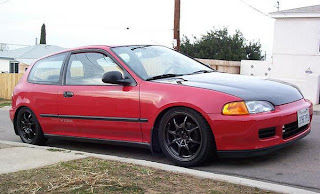The Honda Civic is a compact car manufactured by Honda. It was introduced in July 1972 as a two-door coupe, followed by a three-door hatchback version that September. With the transverse engine placement of its 1169 cc engine and front-wheel drive, like the British Mini, the car provided good interior space despite overall small dimensions.
The fifth generation Civic had a more wedge-shaped body and the wheelbase was increased to 257 cm (101.3 inches) for the two-door hatchback and 262 cm (103.2 inches) for the four-door sedan. The wagon was also dropped for overseas markets, while the previous generation wagon continued (particularly in 4WD form for the Japanese market until 1995, when the Honda CRX , SUV and Honda Orthia wagon were released.
In Thailand, this civic EG6 is very popular one, because it's light weight and can swap engine to hi-performance VTEC engine( 170 bhp without any air-charging system) and also cheaper price ( about 250,000 baht) than many cars.
How's VTEC work?
In the regular four-stroke automobile engine, the intake and exhaust valves are actuated by lobes on a camshaft. The shape of the lobes determines the timing, lift and duration of each valve. Timing refers to an angle measurement of when a valve is opened or closed with respect to the piston position (TDC or BDC). Lift refers to how much the valve is opened. Duration refers to how long the valve is kept open. Due to the behavior of the working fluid (air and fuel mixture) before and after combustion, which have physical limitations on their flow, as well as their interaction with the ignition spark, the optimal valve timing, lift and duration settings under low RPM engine operations are very different from those under high RPM. Optimal low RPM valve timing, lift and duration settings would result in insufficient filling of the cylinder with fuel and air at high RPM, thus greatly limiting engine power output. Conversely, optimal high RPM valve timing, lift and duration settings would result in very rough low RPM operation and difficult idling. The ideal engine would have fully variable valve timing, lift and duration, in which the valves would always open at exactly the right point, lift high enough and stay open just the right amount of time for the engine speed in use.
VTEC was initially designed to increase the power output of an engine to 100 ps/liter or more while maintaining practicality for use in mass production vehicles. Some later variations of the system were designed solely to provide improvements in fuel efficiency, or increased power output as well as improved fuel efficiency.
In practice, a fully variable valve timing engine is difficult to design and implement. Attempts have been made, using solenoids to control valves instead of the typical springs-and-cams setup, however these designs have not made it into production automobiles as they are very complicated and costly.
In the regular four-stroke automobile engine, the intake and exhaust valves are actuated by lobes on a camshaft. The shape of the lobes determines the timing, lift and duration of each valve. Timing refers to an angle measurement of when a valve is opened or closed with respect to the piston position (TDC or BDC). Lift refers to how much the valve is opened. Duration refers to how long the valve is kept open. Due to the behavior of the working fluid (air and fuel mixture) before and after combustion, which have physical limitations on their flow, as well as their interaction with the ignition spark, the optimal valve timing, lift and duration settings under low RPM engine operations are very different from those under high RPM. Optimal low RPM valve timing, lift and duration settings would result in insufficient filling of the cylinder with fuel and air at high RPM, thus greatly limiting engine power output. Conversely, optimal high RPM valve timing, lift and duration settings would result in very rough low RPM operation and difficult idling. The ideal engine would have fully variable valve timing, lift and duration, in which the valves would always open at exactly the right point, lift high enough and stay open just the right amount of time for the engine speed in use.
VTEC was initially designed to increase the power output of an engine to 100 ps/liter or more while maintaining practicality for use in mass production vehicles. Some later variations of the system were designed solely to provide improvements in fuel efficiency, or increased power output as well as improved fuel efficiency.
In practice, a fully variable valve timing engine is difficult to design and implement. Attempts have been made, using solenoids to control valves instead of the typical springs-and-cams setup, however these designs have not made it into production automobiles as they are very complicated and costly.
The opposite approach to variable timing is to produce a camshaft which is better suited to high RPM operation. This approach means that the vehicle will run very poorly at low RPM (where most automobiles spend much of their time) and much better at high RPM. VTEC is the result of an effort to marry high RPM performance with low RPM stability.
Modified EG6!!!











1 ความคิดเห็น:
ทางเข้า Betway Juegos recomendados que se burlan de los jugadores.
Superlot Una red de emoción y diversión.
W88 La diversión surge de jugar al fútbol.
AFB1188 vamos a burlarnos de jugar al fútbol en tu teléfono móvil.
Jack88 Los juegos de tragamonedas en línea crean entretenimiento divertido.
หวยออนไลน์ Sitio web de lotería que combina entretenimiento Y una emoción impactante
แสดงความคิดเห็น